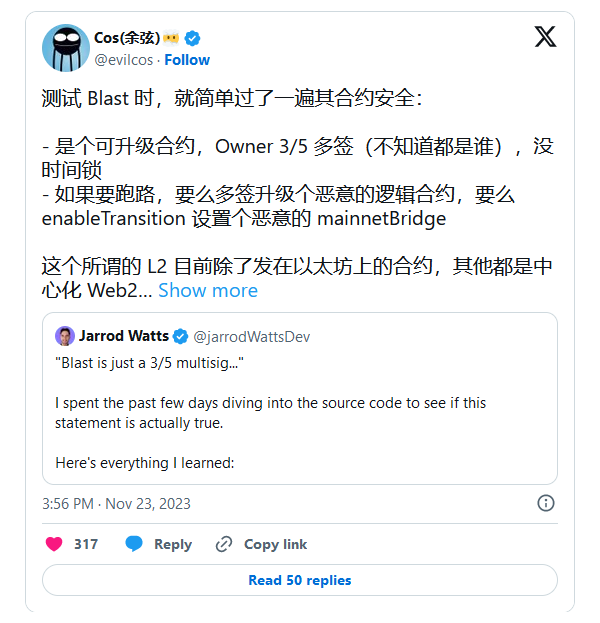Analysts warn that the Blast contract is controlled by anonymous addresses. Users have invested over $300 million in the project
Polygon Labs and SlowMist experts claim that Blast is not a layer 2 network

24.11.2023 - 13:08
288
2 min
0
What’s new? Experts from blockchain developer Polygon and audit firm SlowMist have reported a vulnerability in the Blast project, which was launched by the Blur NFT marketplace team on November 21. According to the analysts, the project is based on a multi-signature contract with instant update capability that requires 3 out of 5 signatures to make changes. In turn, all five signature addresses are anonymous and recently created.
What else is known? In the event of an exploit or bad faith by the owners of the signature-enabled addresses, the Blast contract can instantly inject malicious code updates to steal funds.
The experts added that Blast, unlike other projects with similar features such as Arbitrum, is not a layer 2 (L2) network and is simply a smart contract that accepts deposits and invests them in revenue-generating protocols such as Lido, liquid ETH staking protocol.
Jarrod Watts of Polygon Labs emphasized that Blast has no testnet, bridges, or rollups, and does not even send transaction data to Ethereum.
“By sending money to the Blast contract, you’re basically trusting 3-5 strangers to stake your funds for you. You won’t be able to withdraw that money at any point in time unless those 3-5 people decide to do the right thing in the future,” the developer explained.
Notably, Blast currently lacks a withdrawal feature. According to the roadmap, it will be activated only on February 24 next year. At the same time, users have already blocked over $303 million in the project’s contract.
In turn, SlowMist founder Yu Xiang said that Blast is a centralized Web 2.0 project, which has received support from financial institutions. Thus, one of the investors of the project is the venture capital firm Paradigm, which previously supported the Blur marketplace.
Xiang expressed indignation that users do not study the technical features of the project, judging its reliability only by the presence of institutional partners.
Useful material?
Trends
As of January 21, the capitalization of this sector of the crypto market exceeds $519 billion
Jan 21, 2025
Market
The platform generated $9,5 million in revenue during the same time
Jan 20, 2025
Market
Shares of the Trust are designed to track the market price of XRP with fewer fees and expenses
Jan 17, 2025
Market
The asset will allow USDT to move seamlessly between different blockchains
Jan 17, 2025
Market
Earlier, the community criticized the project for its lack of transparency, which led to a sharp drop in the HYPE token price
Jan 8, 2025
Market
Rising US Treasury bond yields are negatively affecting risk assets
Jan 8, 2025










 Telegram
Telegram  Twitter
Twitter